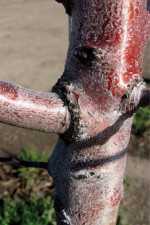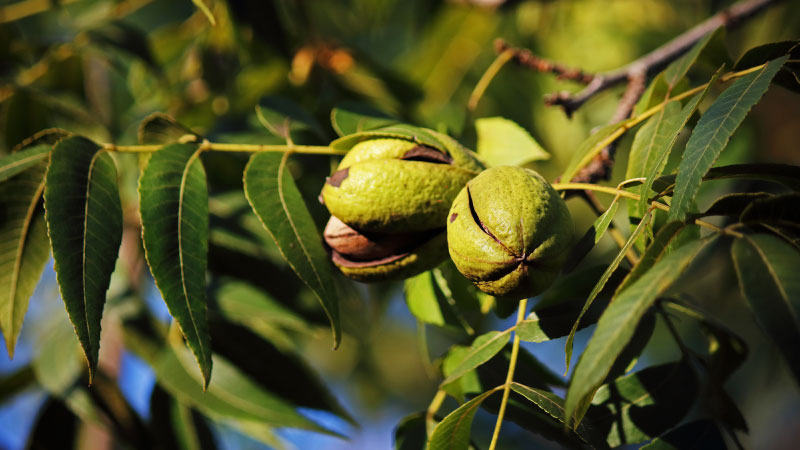Prune Young Almond Trees

California farm advisors from Bakersfield to Chico have completed many pruning trials over the past 30 years, and the results have changed the way we train and prune almond trees. We now know that the more you prune a tree, the lower the yield will be, and the less you prune the heavier the yield. But this does not mean that you shouldn’t prune almond trees! The dormant pruning done to an almond tree after its first and second growing seasons is the most important it will ever receive.
I suggest identifying primary scaffolds with good angles of attachment for structural strength and selecting three main scaffolds spaced vertically and horizontally around the trunk. Avoid poorly attached branches with included bark (see photos of good branch angles versus bad branch angles). These three primary branches permanently establish the tree’s basic framework. Leaving more than three limbs often results in poor crotches, weak branch attachment, and excess breakage when the first big crop is set, particularly when trees are grown on vigorous rootstocks.
From our trials we know that short pruning in the first dormant season, where scaffolds are headed back hard to 12 inches and all side shoots are stripped off, reduces yield the most in the first few harvests. Advantages are that this type of pruning is easily learned and taught, trees are uniformly controlled in size, usually no tying is required in the second growing season, and there are lots of secondary limbs and watersprouts to select from at the second dormant pruning. A drawback is that you guarantee the need for lots of thinning cuts at the second dormant pruning or you end up with way too many “virtual” primary branches and too much crowding. Another concern is you may also need to loop tie the secondary branches in the second dormant season to prevent them from flopping over during the third growing season. Hard heading cuts on vigorous trees results in willowy pole-like branches the next year.
Long Vs. Short Pruning
Long pruning, where three primary scaffolds are selected in the first dormant season and left unheaded, is the other extreme. Small lateral fruit wood is left on the tree and some thinning may be done to select secondary branches. Advantages are earlier production, far fewer thinning cuts needed in the second dormant season, and fewer watersprouts to remove. Disadvantages are that the method is harder to teach and more pruning skill is required, there may be a need to tie vigorous trees in the second growing season to keep the primaries from flopping over, trees are less uniform, and they may be more easily blown over during heavy storms. Similar light thinning is done in the second and third dormant seasons.
I don’t believe that farm advisors have ever advocated non-pruning during the tree training years. Non-pruned trees may have heavier early yield in the third and fourth growing seasons, but those years are the lowest yield years in the orchard’s life. Also, poor bloom weather in the third or fourth year may eliminate any yield advantage a non-pruner was hoping for. Eight or 10 primary scaffolds will develop into a bushy dense tree that is more subject to disease and to blowing over in the establishment years and beyond. Such trees may also be more subject to limb breakage from poor branch attachments. In the northern part of the Central Valley where heavy winter storms are common, the potential cost of tree loss or damage can far outweigh the hoped-for yield gains. If thinning cuts are made on these crowded primaries as the trees age, the remaining limbs result in an even less desirable tree.
The best compromise is intermediate pruning, where three primary scaffolds are selected in the first dormant season, small lateral twigs growing horizontally and non-vigorous lateral branch growth coming from the upper trunk or scaffold branches are left on the tree. The three primary scaffolds are tipped back lightly, usually to about 48 to 60 inches to where internodes are longer so that good secondary branching results. In the second dormant season, vigorous upright secondary branches are thinned out to no more than three on a primary, while once again lateral fruit wood is kept. Disadvantages of this method are similar to long pruning in that this method is harder to teach and trees are more variable.
Advantages include less pruning needed to thin watersprouts in the second dormant season, less need to tie trees, and less limb breakage and a fuller canopy compared to long pruned trees.
Intermediate Pruning Is Best
Early production in trial treatments using intermediate pruning is often very similar to production in the long-pruned check trees. In addition, keeping small lateral shoots and branches has several other benefits compared to short pruning where they are removed. Their leaves shade the trunk and lower limbs and prevent sunburn. Photosynthate produced by these leaves nourishes the lower limbs and trunk and increases their strength. Finally, these lateral branches are the first to spur up and produce a crop.
Little additional training is needed in the third and fourth dormant seasons. The very few thinning cuts made, if the trees have been trained well in the first and second dormant seasons, are confined to maintaining the dominance of the primary and secondary scaffold branches you’ve selected previously. The third dormant pruning should be your final shot at correcting any mistakes made in previous years.
Twenty years ago, many young orchards were pruned way more severely than necessary or desirable. Today, I believe that too often, little to no training is practiced with the mistaken assumption that yield will be the best with no downside. That is not the case. Good intermediate pruning will minimize blow-overs while still returning reasonable early production and longer term tree health.









